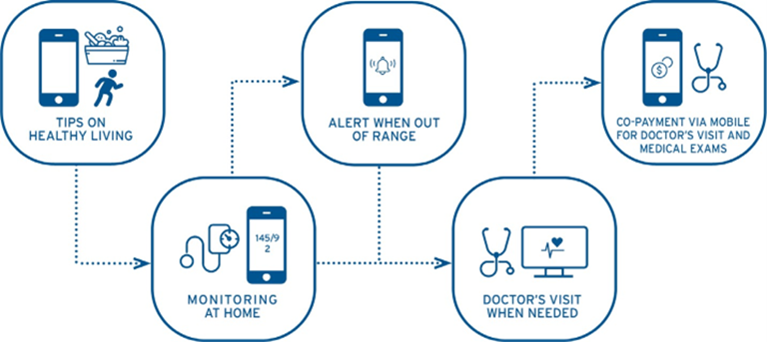Background
In healthcare, particularly in Africa, patient data is fragmented across different formats, databases, time points created at different health care facilities in different locations, making coordinated patient-centric care difficult. In this study, by pooling existing data of diabetes and hypertension patients from different sources (a self-monitoring app, clinic data and data from digital patient surveys) an improved personalized treatment journey can be offered from the provider to the patient. In addition, patients increasingly shared their data. The aggregated health data shared by providers and patients was analyzed for the evaluation of a specific (value-based care) NCD model.
Study Overview
This case study explores the implementation of a digital and mobile-based, patient-centered value-based care model designed to improve hypertension and diabetes care in Kenya. Conducted between 2018 and 2019, the study enrolled 1,626 patients from nine clinics across Nairobi, Kiambu, Nyeri, and Vihiga counties into an integrated NCD care model (Figure 1). Self-management devices were distributed to patients to measure blood pressure (BP) and/or blood glucose (BG) levels at home. Patients were trained to use their devices by a nurse at the clinic, take their measurements at home and enter their readings on a mobile phone application (AfyaPap, developed by Baobab Circle©). In addition, the intervention included a digital partly-subsidized health wallet (M-Tiba) to facilitate co-payment and savings for healthcare expenses. Facility-based peer support groups were established and led by KDDA (Kenya Defeat Diabetes Association) to enhance treatment adherence and health literacy.

Figure 1 Integrated NCD management throughout a patient journey
The data of patient measurements was combined with survey information and M-Tiba visit data, which were used to do risk stratification of patients. The doctors used risk stratified (excel) files to reach out to the patients through telecalls and make sure they were compliant/ monitored.
Key Findings
- Adoption and Acceptability
- 75% of patients engaged in self-monitoring using the provided devices
- 48% participated in peer support groups, benefiting from community engagement and education
- 65% of patients saved funds using M-TIBA for healthcare expenses
- Health Outcomes
- BP and BG control improved significantly with the NCD intervention:
- 50% of hypertensive patients achieved control, compared to 42% at baseline
- 74% of diabetic patients achieved control, compared to 52% at baseline
- Patients who measured their BP at home and participated in peer support groups determined their BP more frequently and had a 21% higher likelihood of controlled BP
This could not be concluded for patient BG measurements, due to too low frequency of observations
Challenges Identified
- Access to medication remained a barrier despite financial assistance, with 48% reporting unmet healthcare needs due to affordability or stock shortages
- Technical limitations with digital tools, especially among patients using non-smartphone devices, reduced uptake of self-monitoring features
- Sustainability concerns related to long-term financing, as public and private insurers were hesitant to adopt co-payment models for chronic care
Implications and Recommendations
- Blended digital and face-to-face support is essential: while digital tools enhance care, peer support groups and in-person engagement play a crucial role in sustaining behavioral changes.
- Medication accessibility must be prioritized: bulk purchasing initiatives through patient groups and improved supply chain management are needed to address shortages and lower prices.
- Digital infrastructure and literacy need improvement: connectivity issues and usability challenges must be addressed, particularly for patients relying on USSD-based tools rather than smartphone apps.
- Healthcare financing requires innovative models: insurance models and government funding should explore co-payment or subsidy mechanisms to ensure affordability and sustainability.
- Scalability of self-monitoring programs should be explored: alternative models such as community-based monitoring at pharmacies or through health workers could enhance accessibility.
Conclusion
This study demonstrates that integrating digital health tools with financial innovations and peer support can significantly improve chronic disease management in LMICs. However, medication access, financial sustainability, and digital literacy barriers must be addressed to ensure long-term success. Future policy efforts should focus on scaling up integrated value-based NCD care models while incorporating strategies to enhance digital inclusion and healthcare financing.
The unique setup of this project is that data from various sources were pooled to make a better estimation of risks for complications of diabetes and hypertension patients (a self-monitoring app, clinic data, m-Tiba healthcare consumption data and data from digital surveys). This helped the doctors to make targeted phone calls to those who were most at risk. In addition, the combined information of all these data helped an independent research institution (APHRC) to make in-depth analyses to evaluate this NCD model for providing information to policy makers and sharing increased knowledge on patient journeys with the (inter)national research community.
Read here the full case study

